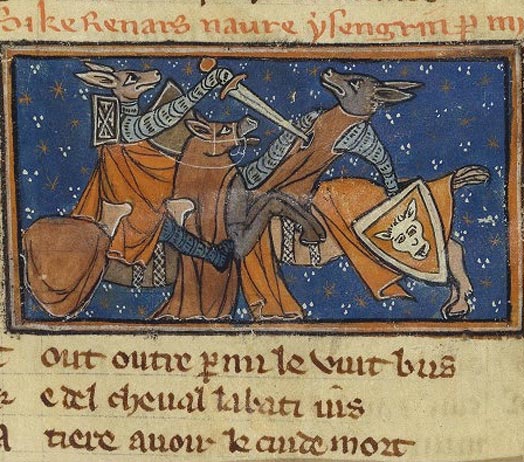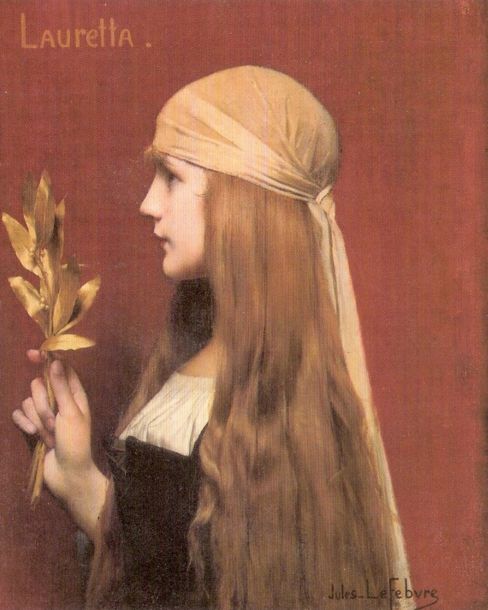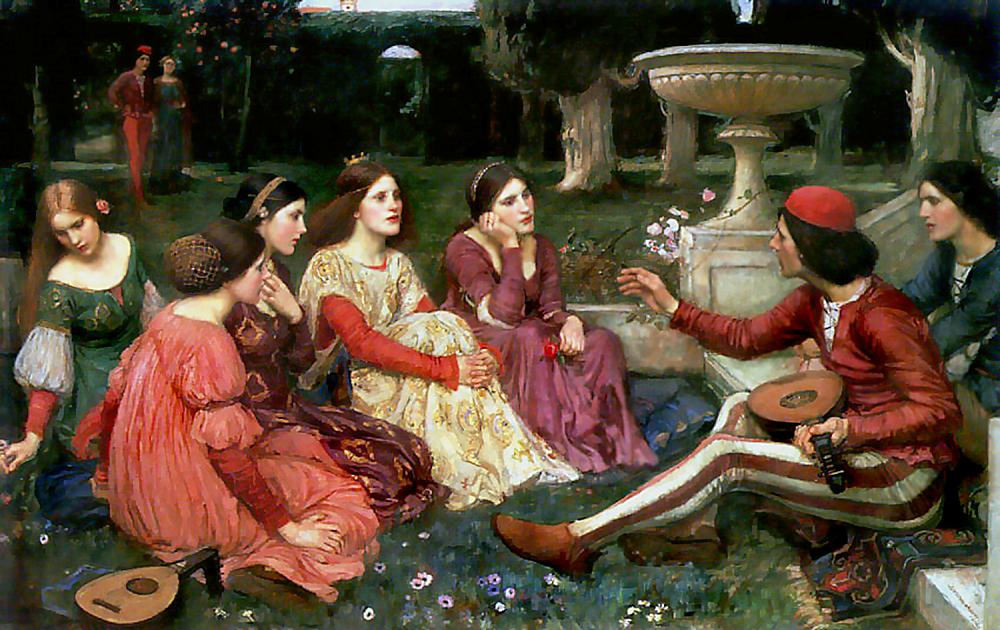|
Fabliau
A ''fabliau'' (; plural ''fabliaux'') is a comic, often anonymous tale written by jongleurs in northeast France between c. 1150 and 1400. They are generally characterized by sexual and scatological obscenity, and by a set of contrary attitudes—contrary to the church and to the nobility. Several of them were reworked by Giovanni Boccaccio for the ''Decameron'' and by Geoffrey Chaucer for his ''Canterbury Tales''. Some 150 French ''fabliaux'' are extant, the number depending on how narrowly ''fabliau'' is defined. According to R. Howard Bloch, ''fabliaux'' are the first expression of literary realism in Europe. Some nineteenth-century scholars, most notably Gaston Paris, argue that ''fabliaux'' originally came from the Orient and were brought to the West by returning crusaders. History and definition of the genre The ''fabliau'' is defined as a short narrative in (usually octosyllabic) verse, between 300 and 400 lines long,Cuddon 301. its content often comic or satiric.Abram ... [...More Info...] [...Related Items...] OR: [Wikipedia] [Google] [Baidu] |
Le Roman De Renart
Reynard the Fox is a list of literary cycles, literary cycle of medieval allegorical Folklore of the Low Countries, Dutch, English folklore, English, French folklore, French and German folklore, German fables. The first extant versions of the cycle date from the second half of the 12th century. The genre was popular throughout the Late Middle Ages, as well as in chapbook form throughout the Early Modern period. The stories are largely concerned with the main character Reynard, an anthropomorphic red fox, trickster figure. His adventures usually involve his deceiving other anthropomorphic animals for his own advantage or trying to avoid their retaliatory efforts. His main enemy and victim across the cycle is his uncle, the wolf, Isengrim (or Ysengrim). While the character of Reynard appears in later works, the core stories were written during the Middle Ages by multiple authors and are often seen as parodies of medieval literature such as courtly love stories and chansons de geste ... [...More Info...] [...Related Items...] OR: [Wikipedia] [Google] [Baidu] |
Richeut
Richeut is the earliest known fabliau, dating from 1159. Although ''Richeut'' shares many of the same characteristics as other fabliaux, it has several unique features: 1. It mentions the outcome of a sexual encounter. 2. It breaks the taboo of incest. 3. It is unusually long, containing 1019 lines. 4. It does not use octosyllables, but a tailrhyme strophe. 5. It has character development. 6. The characters of Richeut and Herselot, the maid, exist outside of this text. Summary This tale recounts the life of a prostitute who uses men to her advantage. She does not discriminate between classes, for she dupes a nobleman, a bourgeois and a clergyman into believing that they are the father of her son, whom she conceived on purpose because she felt that they were no longer paying her enough attention. All three men lavish her and her son with gifts to the point of ruining themselves. Her son, Samson, grows up with all of the privileges that money can buy. Bored by his surr ... [...More Info...] [...Related Items...] OR: [Wikipedia] [Google] [Baidu] |
Rutebeuf
Rutebeuf (or Rustebuef) (fl. 1245 – 1285) was a French trouvère (poet-composers who worked in France's northern dialects). Early life He was born in the first half of the 13th century, possibly in Champagne (he describes conflicts in Troyes in 1249); he was evidently of humble birth, and was a Parisian by education and residence. Career His name is not mentioned by his contemporaries. He frequently plays in his verse on the word ''Rutebeuf'', which was a pen name, and is variously explained by him as derived from ''rude boeuf'' and ''rude oeuvre'' ("coarse ox" or "rustic piece of work"). Paulin Paris thought that he began life in the lowest rank of the minstrel profession as a ''jongleur'' (juggler and musician). Some of his poems have autobiographical value. In ''Le Mariage de Rutebeuf'' ("The Marriage of Rutebeuf") he writes that on 2 January 1261 he married a woman old and ugly, with neither dowry nor amiability. In the ''Complainte de Rutebeuf'' he details a series of ... [...More Info...] [...Related Items...] OR: [Wikipedia] [Google] [Baidu] |
Decameron
''The Decameron'' (; it, label=Italian, Decameron or ''Decamerone'' ), subtitled ''Prince Galehaut'' (Old it, Prencipe Galeotto, links=no ) and sometimes nicknamed ''l'Umana commedia'' ("the Human comedy", as it was Boccaccio that dubbed Dante Alighieri's ''Comedy'' "''Divine''"), is a collection of short stories by the 14th-century Italian author Giovanni Boccaccio (1313–1375). The book is structured as a frame story containing 100 tales told by a group of seven young women and three young men; they shelter in a secluded villa just outside Florence in order to escape the Black Death, which was afflicting the city. Boccaccio probably conceived of the ''Decameron'' after the epidemic of 1348, and completed it by 1353. The various tales of love in ''The Decameron'' range from the erotic to the tragic. Tales of wit, practical jokes, and life lessons contribute to the mosaic. In addition to its literary value and widespread influence (for example on Chaucer's ''Canterbury Ta ... [...More Info...] [...Related Items...] OR: [Wikipedia] [Google] [Baidu] |
Decamerone
''The Decameron'' (; it, label=Italian, Decameron or ''Decamerone'' ), subtitled ''Prince Galehaut'' (Old it, Prencipe Galeotto, links=no ) and sometimes nicknamed ''l'Umana commedia'' ("the Human comedy", as it was Boccaccio that dubbed Dante Alighieri's ''Comedy'' "''Divine''"), is a collection of short stories by the 14th-century Italian author Giovanni Boccaccio (1313–1375). The book is structured as a frame story containing 100 tales told by a group of seven young women and three young men; they shelter in a secluded villa just outside Florence in order to escape the Black Death, which was afflicting the city. Boccaccio probably conceived of the ''Decameron'' after the epidemic of 1348, and completed it by 1353. The various tales of love in ''The Decameron'' range from the erotic to the tragic. Tales of wit, practical jokes, and life lessons contribute to the mosaic. In addition to its literary value and widespread influence (for example on Chaucer's ''Canterbury Tales' ... [...More Info...] [...Related Items...] OR: [Wikipedia] [Google] [Baidu] |
Canterbury Tales
''The Canterbury Tales'' ( enm, Tales of Caunterbury) is a collection of twenty-four stories that runs to over 17,000 lines written in Middle English by Geoffrey Chaucer between 1387 and 1400. It is widely regarded as Chaucer's ''magnum opus''. The tales (mostly written in verse, although some are in prose) are presented as part of a story-telling contest by a group of pilgrims as they travel together from London to Canterbury to visit the shrine of Saint Thomas Becket at Canterbury Cathedral. The prize for this contest is a free meal at the Tabard Inn at Southwark on their return. It has been suggested that the greatest contribution of ''The Canterbury Tales'' to English literature was the popularisation of the English vernacular in mainstream literature, as opposed to French, Italian or Latin. English had, however, been used as a literary language centuries before Chaucer's time, and several of Chaucer's contemporaries—John Gower, William Langland, the Pearl Poet, and J ... [...More Info...] [...Related Items...] OR: [Wikipedia] [Google] [Baidu] |
Novel
A novel is a relatively long work of narrative fiction, typically written in prose and published as a book. The present English word for a long work of prose fiction derives from the for "new", "news", or "short story of something new", itself from the la, novella, a singular noun use of the neuter plural of ''novellus'', diminutive of ''novus'', meaning "new". Some novelists, including Nathaniel Hawthorne, Herman Melville, Ann Radcliffe, John Cowper Powys, preferred the term "romance" to describe their novels. According to Margaret Doody, the novel has "a continuous and comprehensive history of about two thousand years", with its origins in the Ancient Greek and Roman novel, in Chivalric romance, and in the tradition of the Italian renaissance novella.Margaret Anne Doody''The True Story of the Novel'' New Brunswick, NJ: Rutgers University Press, 1996, rept. 1997, p. 1. Retrieved 25 April 2014. The ancient romance form was revived by Romanticism, especially the histori ... [...More Info...] [...Related Items...] OR: [Wikipedia] [Google] [Baidu] |
Jongleur
A minstrel was an entertainer, initially in medieval Europe. It originally described any type of entertainer such as a musician, juggler, acrobat, singer or fool; later, from the sixteenth century, it came to mean a specialist entertainer who sang songs and played musical instruments. Description Minstrels performed songs which told stories of distant places or of existing or imaginary historical events. Although minstrels created their own tales, often they would memorize and embellish the works of others. Frequently they were retained by royalty and high society. As the courts became more sophisticated, minstrels were eventually replaced at court by the troubadours, and many became wandering minstrels, performing in the streets; a decline in their popularity began in the late 15th century. Minstrels fed into later traditions of travelling entertainers, which continued to be moderately strong into the early 20th century, and which has some continuity in the form of today's bu ... [...More Info...] [...Related Items...] OR: [Wikipedia] [Google] [Baidu] |
Prose
Prose is a form of written or spoken language that follows the natural flow of speech, uses a language's ordinary grammatical structures, or follows the conventions of formal academic writing. It differs from most traditional poetry, where the form consists of verse (writing in lines) based on rhythmic metre or rhyme. The word "prose" first appears in English in the 14th century. It is derived from the Old French ''prose'', which in turn originates in the Latin expression ''prosa oratio'' (literally, straightforward or direct speech). Works of philosophy, history, economics, etc., journalism, and most fiction (an exception is the verse novel), are examples of works written in prose. Developments in twentieth century literature, including free verse, concrete poetry, and prose poetry, have led to the idea of poetry and prose as two ends on a spectrum rather than firmly distinct from each other. The British poet T. S. Eliot noted, whereas "the distinction between verse and pro ... [...More Info...] [...Related Items...] OR: [Wikipedia] [Google] [Baidu] |
Voltaire
François-Marie Arouet (; 21 November 169430 May 1778) was a French Age of Enlightenment, Enlightenment writer, historian, and philosopher. Known by his ''Pen name, nom de plume'' M. de Voltaire (; also ; ), he was famous for his wit, and his criticism of Christianity—especially Criticism of the Catholic Church, of the Roman Catholic Church—and of slavery. Voltaire was an advocate of freedom of speech, freedom of religion, and separation of church and state. Voltaire was a versatile and prolific writer, producing works in almost every literary form, including stageplay, plays, poems, novels, essays, histories, and scientific Exposition (narrative), expositions. He wrote more than 20,000 letters and 2,000 books and pamphlets. Voltaire was one of the first authors to become renowned and commercially successful internationally. He was an outspoken advocate of civil liberties and was at constant risk from the strict censorship laws of the Catholic French monarchy. His polemics ... [...More Info...] [...Related Items...] OR: [Wikipedia] [Google] [Baidu] |
Molière
Jean-Baptiste Poquelin (, ; 15 January 1622 (baptised) – 17 February 1673), known by his stage name Molière (, , ), was a French playwright, actor, and poet, widely regarded as one of the greatest writers in the French language and world literature. His extant works include comedies, farces, tragicomedies, comédie-ballets, and more. His plays have been translated into every major living language and are performed at the Comédie-Française more often than those of any other playwright today. His influence is such that the French language is often referred to as the "language of Molière". Born into a prosperous family and having studied at the Collège de Clermont (now Lycée Louis-le-Grand), Molière was well suited to begin a life in the theatre. Thirteen years as an itinerant actor helped him polish his comedic abilities while he began writing, combining Commedia dell'arte elements with the more refined French comedy. Through the patronage of aristocrats including ... [...More Info...] [...Related Items...] OR: [Wikipedia] [Google] [Baidu] |
Jean De La Fontaine
Jean de La Fontaine (, , ; 8 July 162113 April 1695) was a French fabulist and one of the most widely read French poets of the 17th century. He is known above all for his ''Fables'', which provided a model for subsequent fabulists across Europe and numerous alternative versions in France, as well as in French regional languages. After a long period of royal suspicion, he was admitted to the French Academy and his reputation in France has never faded since. Evidence of this is found in the many pictures and statues of the writer, later depictions on medals, coins and postage stamps. Life Early years La Fontaine was born at Château-Thierry in France. His father was Charles de La Fontaine, maître des eaux et forêts – a kind of deputy-ranger – of the Duchy of Château-Thierry; his mother was Françoise Pidoux. Both sides of his family were of the highest provincial middle class; though they were not noble, his father was fairly wealthy. Jean, the eldest child, was educa ... [...More Info...] [...Related Items...] OR: [Wikipedia] [Google] [Baidu] |







.jpg)
